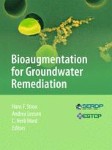Search
Search Results
-
Biotreatability of Industrial Hazardous Wastes
Hazardous waste contamination due to industrial activity is now identified as a potential risk to both the environment and serious health problems....
-
Biological treatment of oil and gas produced water: a review and meta-analysis
Biological treatment is effective but infrequently used for oil and gas produced water. To date, physical–chemical treatment methods have been...

-
Bioassays with terrestrial and aquatic species as monitoring tools of hydrocarbon degradation
In this study chemical analyses and ecotoxicity tests were applied for the assessment of a heavily hydrocarbon-contaminated soil prior and after the...

-
Cost Analyses For Remedial Options
The economic analysis of remedial options is a key activity in any remedial selection process. Typically, the capital and recurring costs of various...
-
The Impact of Process Sequences on Pollutant Removal Efficiencies in Tannery Wastewater Treatment
A laboratory-scale study was conducted to determine the removal efficiencies of nine contaminants from a tannery wastewater using a number of...

-
Bioaugmentation Considerations
Bioaugmentation can be employed in bioremediation systems to improve the rate and extent of solvent remediation. This chapter is intended to assist...
-
Synthesising acid mine drainage to maintain and exploit indigenous mining micro-algae and microbial assemblies for biotreatment investigations
The stringent regulations for discharging acid mine drainage (AMD) has led to increased attention on traditional or emerging treatment technologies...

-
Full-Scale Remediation of a Jet Fuel-Contaminated Soil: Assessment of Biodegradation, Volatilization, and Bioavailability
Here, we addressed biodegradation vs. volatilization processes, and also bioavailability limitations during biopile remediation of soil initially...

-
Cost Analyses for Remedial Options
The economic analysis of remedial options is a key activity in any remedial selection process. It is typically employed in the feasibility study...
-

-
Bioremediation of petroleum hydrocarbons through landfarming: Are simplicity and cost-effectiveness the only advantages?
The biological removal of petroleum products using landfarming has been applied commercially in large scale with relative success. The technology has...
-

-
The Binary Treatment of Aqueous Metribuzin Using Anodic Fenton Treatment and Biodegradation
An advanced oxidation process, anodic Fenton treatment (AFT), and a mixed microbial culture were used to degrade metribuzin...
-
Biotreatability and Kinetics of UASB Reactor to Mixtures of Chlorophenol Pollutants
In most natural ecosystems heterotrophic microorganisms encountercomplex mixtures of carbon sources, each of which is present at aconcentration of...
-
Biodegradation and Bioremediation of Petroleum Pollutants in Soil
Petroleum and its derived fuels, as a result of their widespread worldwide use, are probably the most ubiquitous organic pollutants found in soil....
-
Biodegradability Assessment of Ozonated Raw and Biotreated Pharmaceutical Wastewater
The activated sludge specific oxygen uptake rate (SOUR) and BOD 5 /COD ratios of biologically pretreated pharmaceutical wastewater were analyzed and...
-
Oxidation of 2,4-Dinitrophenol by Hydrogen Peroxide in the Presence of Basic Oxygen Furnace Slag
A treatment process was developed when basic oxygen furnace slag (BOF slag) and hydrogen peroxide were used to oxidize 2,4-dinitrophenol from an...
-
Solvent selection guide: a guide to the integration of environmental, health and safety criteria into the selection of solvents
A practical, easy to use Solvent Selection Guide has been developed to provide a concise source of selected information and guidance to chemists and...
-
Decolorization and Detoxification of Bleached Kraft Effluents
The pulp and paper industry ranks third in terms of water consumption and fifth among the major industries in its contribution to water pollution...
